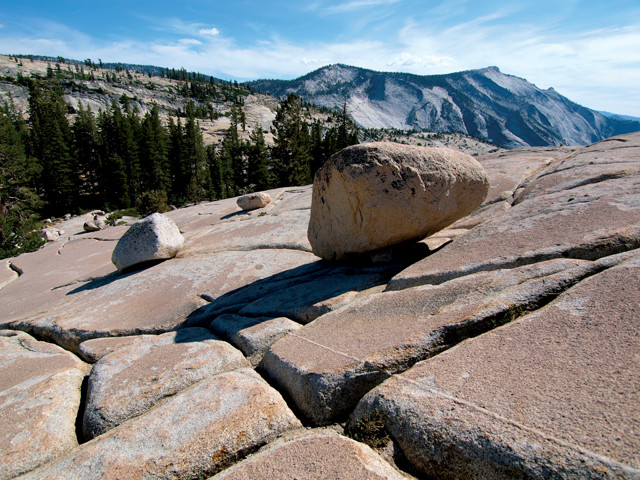
by Mary Caperton Morton Wednesday, May 17, 2017

Potassium feldspar is one of the main mineral components of Yosemite's famous granite, giving it a pinkish hue. Credit: Mary Caperton Morton.
For water vapor in the atmosphere to transform into icy, cloud-forming droplets, it needs a seed around which to condense, such as aerosols, sea salt or bacteria. One of the most effective seeds is mineral dust, in particular potassium feldspar, one of the main ingredients in granite. New research tracking fluxes of potassium feldspar in the atmosphere through geologic time is shedding light on the long-term importance of the mineral in cloud formation and climate feedback cycles.
“Potassium feldspar is far and away the most efficient ice-nucleating dust agent in the atmosphere,” says Matt Pankhurst, a geologist at the University of Leeds in England and author of a new study in Geology. The main sources for potassium feldspar are felsic magmas, which form granites and rhyolites. When felsic rocks erode, small particles of minerals can be carried aloft by wind and storms, persisting in the atmosphere for days to weeks. Potassium feldspar first came on the scene roughly 3 billion years ago, when the first large igneous provinces of felsic rocks appeared.
“The amount of potassium feldspar available at [Earth’s] surface fluctuates a lot through geologic time,” Pankhurst says, mostly by virtue of changing atmospheric conditions and land surface changes due to glaciation. When land is completely buried under ice, rocks and minerals beneath the ice have no direct way to get into the atmosphere so, at peak glacial times, their influence on climate may be limited. During times of partial glaciation, the amount of dust often increases due to the copious amounts of fine-grained sediment produced by glacial erosion. “Glaciation could in fact promote a pathway to the sky,” Pankhurst says, with potassium feldspar “hitching a ride on subglacial rivers and washing out into very fine-grained sediments that are easily picked up by wind.”
Pankhurst says he did not try to quantify the exact amount of potassium feldspar available through geologic history. Instead, he delineated times in Earth’s history when feldspar availability would have been higher or lower, such as during times of copious felsic volcanism or widespread glaciation, respectively. “Today, we’re not at the maximum or the minimum, but rather somewhere in between,” as large felsic igneous provinces aren’t being produced currently and there isn’t global glaciation, Pankhurst says. However, he wrote in Geology, present potassium feldspar flux is likely to be highly variable right now “given the significant land surface changes within an interglacial epoch.”
“The most important contribution of this study is the concept in itself,” says Alex Harrison, an atmospheric scientist also at the University of Leeds who was not involved in the study. “We can now start to expand our understanding of ice nucleation in the past. I personally think there need to be more field studies to understand the role of feldspar and other ice-nucleating particles in the atmosphere and how they compete with one another.”
An important step in improving climate models is to better understand why potassium feldspar is such an efficient ice-nucleating agent, Harrison adds. “We assume there is some sort of active site on a feldspar surface, which helps initiate freezing at warmer temperatures,” he says, but that’s not clear. Furthermore, not all feldspars have the same ice-nucleating ability. “The feldspar group of minerals is varied and complex. Within the feldspar group there is a wide variability of ice-nucleation activity,” Harrison says, most likely related to differences in magmatic composition and cooling history. “It’s interesting to think about the influence of geologic processes and how they may affect climate.”
© 2008-2021. All rights reserved. Any copying, redistribution or retransmission of any of the contents of this service without the expressed written permission of the American Geosciences Institute is expressly prohibited. Click here for all copyright requests.